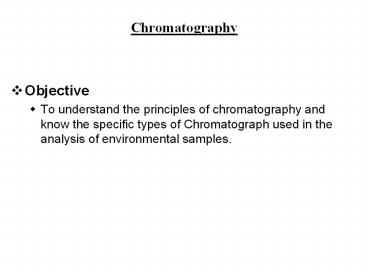Chromatography - PowerPoint PPT Presentation
Title:
Chromatography
Description:
Objective To understand the principles of chromatography and know the specific types of Chromatograph used in the analysis of environmental samples. – PowerPoint PPT presentation
Number of Views:166
Avg rating:3.0/5.0
Title: Chromatography
1
Chromatography
- Objective
- To understand the principles of chromatography
and know the specific types of Chromatograph used
in the analysis of environmental samples.
2
Chromatography
- Background
- HPLC
- Gas Chromatography
- Ion Chromatography
3
Chromatography
- Definition
- Chromatography is a separation technique in which
component molecules (solutes) are transported by
a mobile phase over a stationary phase. - Interaction with the stationary phase causes a
distribution of solutes within the mobile phase. - This interaction affects the rate at which
solutes pass through. - Solutes detected as they exit the stationary
phase.
4
Development of Chromatography
- Discovered 1850
- Dyes separated on paper (water stain)
- Circular Chromatograms
- Planar Chromatography
- Paper Chromatography
- Ascending Solvent system
- Retardation Factor (Rf)
- Dyes, biochemicals, chlorophyll,
- Thin Layer Chromatography (TLC)
- Alumina with varying hydrophobicity
- 2-Dimension TLC - amino acids
5
Development of Chromatography
- Liquid Chromatography
- Mobile Phase is a liquid (water, solvent etc.)
pumped at Low Pressure. - Stationary Phase is a Column filled with a solid
packing material (small beads). - Gel Permeation Chromatography (GPC)
- Stationary Phase has pores of specific size
- Separation is on Physical Dimensions of solute
- Useful for Biopolymer separations - Enzyme
Purification - Solutes are Eluted in order , Largest first.
- Detected by UV Absorbance.
6
Analytical Chromatography
- Principles
- Partitioning between Phases gives Retention Time.
- Separation efficiency
- Peaks should not overlap
- Baseline Resolution
- Compromise Speed and Efficiency
- Small Stationary Phase Particles - Backpressure
- Elution rate
- Quantification
- Detector Response
- Peak shape
- Peak Area
- Standards
7
Analytical Chromatography
- External Standards
- Standard mixtures of solutes at known
concentration. - Injected several times
- Obtain an Average Detector Response for a given
amount. - Internal Standard (better)
- A known amount of a standard compound added to
Every Sample. - Detector response of Solute relative to Standard
is the same in each run. - independent of actual response of detector.
8
- High Performance (Pressure) Liquid Chromatograph
(HPLC)
- Flexible, High Resolution
- Very good for non-volatile chemicals
- sugars, labile organics, pesticides
- liquid mobile phase
- polar or non-polar
- Isocratic (same strength)
- Gradient (concentration changes)
- liquid stationary phase
- polar or non polar
9
HPLC
- Columns short, not heated, densely packed with
small particles (5 - 10 ?m) - Very high pressure (8000 psi)
- Detectors eg
- UV absorbance
- conductivity
- fluorescence
- Derivatisation
- pretreatment of chemical to make detection easier
- e.g. Fluorescent
10
- Gas Chromatography (GC)
- Mobile Phase - Gas
- Helium, Hydrogen - constant flow rate
- Stationary Phase Liquid (GLC)
- Gas liquid chromatography
- Liquid present as a layer on a solid particle
- Polar or Non-polar
- Stationary Phase Solid
- Gas solid chromatography
- Separates stable volatile (organics)
- e.g. THMs, Organohalogens, Solvents, PCBs,
Organophosphates, Drugs, Fatty acids etc.
11
Components of a Gas Chromatograph (GC)
- Injector
- Heated - Programmable
- Column
- Packed (2 - 10 m) diameter 5 mm
- Capillary (10 - 30 m) diameter 0.25 mm
- Oven (for Column)
- Programmable Temperature Gradients
- Very Precise Control
- Detector
- Many types, compound specific (sensitivity)
- Data Processing
12
Sample Injection in GC
- Direct On-Column
- Small quantities
- Guard column protects analytical column
- Flash Vapourisation
- glass or quartz liner
- Split or Splitless for Capillary Columns
- when concentrations of compound are high
- Purge and Trap
- Good for volatiles in water (low levels)
- Sample is purged with bubbles
- Stripped Volatiles adsorb onto a trapping column
- Trapping column inserted into GC injector port
13
Detectors
- Flame Ionisation Detector (FID)
- Detects most Organics
- Current across a hydrogen flame
- Sensitivity 1 ng/l, Linear Dynamic Range (LDR) is
107 - Electron Capture Detector (ECD)
- Detects trace environmental Pollutants e.g.
Pesticides and Herbicides that have
Electronegative atoms (Chlorine). - Radioactive 63Ni - electrons captured by
compounds. - Sensitivity 0.01 ng/l, Linear Dynamic Range (LDR)
is 104
14
Detectors
- Thermal Conductivity Detector (TCD)
- resistance of a wire varies with temperature
- carrier gas is affected by the compounds it
contains. - Good for gases (methane, carbon monoxide,
Hydrogen) - Sensitivity 0.1 mg/l , Linear Dynamic Range
(LDR) is 104 - Mass Selective Detector (MSD)
- Mass spectrum taken continuously
- Single ion or complete spectra
- Sensitivity 1 ng/l
- Others, Flame Photometry, Photo ionisation,
Thermionic.
15
Ion Chromatography (Dionex)
- Variation of HPLC
- Detects Anions and Cations
- ion exchange column (charged stationary phase)
- mobile phase has competing ions (exchange with
solutes) - Detection
- Conductivity or Absorbance of the column
effluent. - Sensitivity Improved by Suppression of background
conductivity of the mobile Phase. - Suppressor Column (ion exchange)
- Electrochemical Suppression































